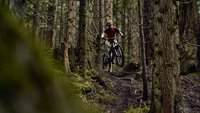
Dave Goes Gucci
Ibis Ripley: First Impressions
Around these here parts we have what we like to call a "Cam McRae build." Generally speaking, it's whatever bike of the moment shows up with a dentist build and a sparkly paint job and that inevitably gets scooped up for testing by its namesake. Occasionally Pete gets a hold of one of these builds, if Cam happens to be tied up with a Guccier build. And, even more rarely, one of these bikes slips down to the rest of us minions. This here bike...this bicycle that is worth 9199 American Dollars. Well. It's a full on Cam McRae build.*
What that means is that this is, by far, the most expensive bicycle I've ever ridden...I think. It's up there, anyhow. And what that also means is that it needs to be treated with a degree of criticality that befits its price tag. Any bike worth this much money had better be damn near to perfect.
*Uncle Dave seems to have forgotten about his e-bike experience. He has certainly ridden bicycles with electric motors that retail for more than 9199 USD. – Ed.
Parts
We'll start this preview with a breakdown and a brief discussion of the parts that make up this here bicycle. After all, if you were looking for an answer to "where did all the money go?," this would be a great place to start.
Most interesting of all of the parts, is the (nearly complete) XTR gruppo hanging off the various ends of things. You've got the brand new 12 speed drivetrain, with the 10-51T cassette. You've got the brand new XTR 2 piston brakes, with the fancy 180mm rotors. And...well...that's it. Filling the place of the missing XTR crankset is a Race Face Next, complete with a 32 tooth chainring.
Now, I'm not going to lie to you. My first few moments of XTR left me feeling a tiny bit underwhelmed. There's just something about the latest incarnations of higher end Shimano trigger shifters that leaves me wanting. Is it crazy that I prefer the feel of their cheaper shifters? The thumb shifter is no big deal, but the trigger requires a substantial amount of force to actuate, and just feels a bit strange to me. Really though, you get used to this fairly quickly, and I'm sure many people will love it.
Once you move past that...holy crap. I'm not saying anything new here, but the new XTR kicks out shifts like nothing I've ever experienced before. It's not actually apparent until you start shifting under less than ideal circumstances. Bang off a couple of shifts on a steep, technical climb and you start to realize just how much you have to adjust your shifting technique with most drivetrains. With XTR, you back off your pedal stroke like you normally do, brace for some grinding noises and clunking and...nothing. It just bangs out a crisp, quiet shift. It's quite special.
On the braking front, things are a bit more interesting. These are, as mentioned, the 2 piston versions of the XTR brake, and they're not really meant for any fancy enduroing. They do work well under most "trail" conditions. They do show a fair amount more modulation than I'm used to experiencing with Shimano brakes, but, and we'll talk about this a bit later, the abilities of this bike let you get into places where these brakes are in over their head. I'm talking about steep, bounce your ass off the back tire types of trails that the folks at Shimano probably assume you are using 4 piston brakes for. Once you hit that type of terrain, these brakes require a bit of a death squeeze to reign things in. If I was forced to make a comparison, power is somewhere in the ballpark of a SRAM dGuide brake.

Oh boy! Ohboyohboyohboy!

Race Face on crank duties.

It feels like we've been waiting a long time for this.

The bike yoke dropper is gaining cult-like status.

The bar has an interesting bend when viewed from this angle, but feels pretty normal in your hands.

Two piston stoppers are what you would expect on a bike with this amount of travel.

Not the latest and greatest rim from Ibis, but still pretty nice.
Moving along, Fox is on suspension, with a Factory Series 130mm Float 34 up front, and the Factory Series DPS/EVOL in the rear (190mmx45mm). We'll leave that for the full review.
Wheels are Ibis' own 935 Carbon Fiber rims laced to Industry 9 Hubs (which will probably be the new S35's if you get around to buying one of these yourself). Ibis also throws in their own carbon fiber handlebar, and a stem made out of what looks like aluminum to me. We're also going to leave that for the full review.
Tires started out as Schwalbe 2.35's ...Nobby Nic on the rear and a Hans Dampf on the front, although Ibis does offer a few different tire options including a Maxxis Assegai WT 2.5 EVO+'s. But more on that during the full review.
The last component of interest is the Bike Yoke Revive Dropper (180mm) topped with a WTB Silverado saddle. Both of these have just been quietly doing their thing. The Bike Yoke required a lone revive, after I pulled it out of the box that it came in. After that, it's been remarkably stable. Lever action is light and the post is easy to control.
So, upon first glance, it looks like Ibis has done a pretty good job of spending your money on parts for this bike. It's not perfection, but there is not a whole bunch to complain about.
The Frame
Getting back to the thing that those parts attach to, we have the frame (available for US$2833 all on its own...well...with a shock, I would assume).
The frame is carbon fiber (of course), and comes with 120mm of DW-linked travel. Geometry is (of course) longer and slacker than with the previous generation. Even so, the numbers are by no description "radical," save for perhaps the 76 degree seat tube angle.

Beyond that, the frame lives up to the price tag. Lines are clean and everything looks and feels "premium." I would worry a bit if I had to be the guy that was swapping cables on this thing...but apparently there's tubes in tubes to make that job a whole lot easier than it looks like it will be.

Clean and smooth.

There's bushings lurking down there somewhere.

Carbon on carbon.

Plenty of room for wider meat.

More clean lines.
Initial Ride Impressions of the Ibis Ripley
The thing I need to keep reminding myself as I review this bike, is that it only has 120mm of travel in the rear and I need to tone my expectations down to that level. If one wanted a more downhill focussed bike, they would probably look to the Ripmo rather than this bike, and it would be somewhat unfair to judge the Ripley using the expectations of the Ripmo. But then I remember the price tag, and maybe it is fair to expect such things from such a high dollar bicycle?
And really, that's where the problems start. I mean..."problems." The thing is, the Ripley lets you get into the sort of trouble on which you'd be better served by a Ripmo. It scoots in and out of corners so quickly, and it handles steeps so well that you kind of forget you're on a bike with only 120mm of travel and you start to wonder why your body is getting beat up so badly. How are you supposed to judge a bike like that?
And climbing...my goodness. I mean, it's not exactly an XC rocket pedalling up mellow gravel roads, but it's no slouch either. And when things get steep and technical, holy cow! To insert a mild spoiler for the full review...I don't think I've ever experienced a bike that makes challenging climbs so easy.
And...well...We'll leave it there for now, because if I don't watch myself, this will turn into a full on bike review.
Find the 2019 Ibis Ripley here.







Comments
AJ Barlas
4 years, 9 months ago
I haven't tried the newer Shimano shifters but in the SRAM range, I feel the same as you. I want the more positive feel of the GX with the adjustability of the X0. The rounded edges of the X0 are evidence of design going too far imo.
Reply
Trent Blucher
4 years, 9 months ago
The X.01 shifter is definitely the best combination. It feels better than the top end, but retains the angle adjustment. At least in the 11spd range...
Reply
qduffy
4 years, 9 months ago
Ibis always seems to under-brake their bikes. My HD3 came with itty bitty brakes and the HD4 I demo'd in Santa Cruz had like 180/160 rotors with two piston XTs. Not enough for what those bikes could do.
We need BC quality brakes.
Reply
Kenny
4 years, 9 months ago
Interested to hear the full review, Dave! Your internal conflict of the "problems" of a capable, but short travel bike resonate with me.
I always like the idea of bikes like this or the trance 29, I'm very much fitness limited and better at descending than ascending and often wonder if this type of bike would bring with it an efficiency that helps prop up my weaknesses. I definitely get up the hill easier on my hardtail than my 150 bike, but the hardtail is actually exhausting going back down, so the net difference is not much.
I tend to wonder if these short travel 29ers are a sweet spot in terms of getting as much out of a given fitness level as possible. For me anything that allows me to ride more without bonking is worth potential tradeoffs in outright speed. Yes I could also just get more fit. Working on that too. Kinda. :)
Reply
Frederic de Montaigu
4 years, 9 months ago
This is a very easy dilemma to resolve.
What are the trails you ride 99% of the time like?
I know why I got a Ripley and not a Ripmo. I need a Ripmo 5% of my riding and this is when I race or hit the bike park. Then I take the big bike out (or rent one if I didn't have a second bike)
90% of the rider I know on a Ripmo would be better served by a Ripley 4.
Except when they mess up and then they are glad they ride a more "forgiving" bike.
But I don't. I use the right tool for the right job.
Reply
Kenny
4 years, 9 months ago
No offense, but I'm not convinced that solution really applies all that well to people who live and ride in the sea to sky area, because you can and do access a huge variety of terrain in a single ride.
The type of trails I ride 99% of the time is "all of them". On a 3 hour ride I'll ride pretty equal amounts of fire road climb, technical singletrack climb, flow, and gnar. It's the shore so maybe a bit of a bias to gnar, but still...
That's part of what makes bike selection interesting here. The most common approach is to be super fit and ride a pretty big bike but as smaller bikes get more capable the options expand in terms of what you can realistically ride all trails with, without getting the crap beaten out of you (at least, too badly)
Reply
Timer
4 years, 9 months ago
As long as it isn't super exhausting, i like a "less capable" bike on the downhills. Then i spend a greater share of my riding time on the way down and less on the way up.
Reply
Please log in to leave a comment.